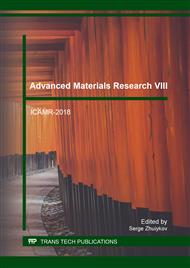[1]
B. Suhendro: Toward green concrete for better sustainable environment, Procedia Engineering Vol. 95 (2014), pp.305-320.
DOI: 10.1016/j.proeng.2014.12.190
Google Scholar
[2]
O. A. Mohamed and O. F. Najm: Compressive Strength and Stability of Sustainable Self-Consolidating Concrete Containing Fly Ash, Silica Fume, and GGBS, Jr. of Frontiers in Structural and Civil Engineering Springer (2017).
DOI: 10.1007/s11709-016-0350-1
Google Scholar
[3]
O. A. Mohamed and O. Najm: Splitting Tensile Strength of Self-Consolidating Concrete Containing Slag, Proceedings of AES-ATEMA International Conference, Advances and Trends in Engineering Materials and their Applications (2016), pp.109-114.
Google Scholar
[4]
O. A. Mohamed, Z. S. Imam, and O. F. Najm: Splitting tensile strength of sustainable self-consolidating concrete, Procedia Engineering - Elsevier Vol. 145 (2016), P. 1218–1225.
DOI: 10.1016/j.proeng.2016.04.157
Google Scholar
[5]
O. A. Mohamed and O. F. Najm: Experimental Validation of Splitting Tensile Strength of Self Consolidating Concrete, Applied Mechanics and Materials Vol. 864 (2017), pp.308-312.
DOI: 10.4028/www.scientific.net/amm.864.308
Google Scholar
[6]
O. A. Mohamed, M. Ati and O. F. Najm: Validation of the Splitting Tensile Strength Formula for Concrete Containing Blast Furnace Slag, Key Engineering Materials Vol. 744 (2017), pp.136-140.
DOI: 10.4028/www.scientific.net/kem.744.136
Google Scholar
[7]
F. A. Oluokun, E. G. Burdette, and J. H. Deatherage: Splitting Tensile Strength and Compressive Strength Relationship at Early Ages, ACI materials journal (1991), pp.115-121.
DOI: 10.14359/1859
Google Scholar
[8]
C. Gaedicke, A. Torres, K. Huynh and A. Marines: A method to correlate splitting tensile strength and compressive strength of pervious concrete cylinders and cores, Construction and Building Materials (2016), pp.271-278.
DOI: 10.1016/j.conbuildmat.2016.08.031
Google Scholar
[9]
JSCE: Standard specifications for concrete structures, Materials and Construction, Japan Society of Civil Engineers, (2007).
Google Scholar
[10]
JCI: Guidelines for Control of Cracking of Mass Concrete, Japan Concrete Institute, (2008).
Google Scholar
[11]
ACI 318: Building code requirements for structural concrete and commentary, American Concrete Institute, Farmington Hills, Mich (2014).
Google Scholar
[12]
BS EN 12390-3:2009: Testing hardened concrete Part 3. Compressive Strength of Test Specimens, British Standards Institution (2009).
Google Scholar
[13]
BS EN 12390-6:2009: Testing hardened concrete Part 6. Tensile Splitting Strength of Test Specimens, British Standards Institution (2009).
DOI: 10.3403/30200045
Google Scholar
[14]
ASTM- C496: Standard Test Method for Splitting Tensile Strength of Cylindrical Concrete Specimens, West Conshohocken: ASTM international (1996).
Google Scholar
[15]
M. A. Mansur and M. M. Islam: Interpretation of concrete strength for nonstandard specimens, J. Mater. Civil Eng Vol. 14(2) (2002), pp.151-155.
DOI: 10.1061/(asce)0899-1561(2002)14:2(151)
Google Scholar


